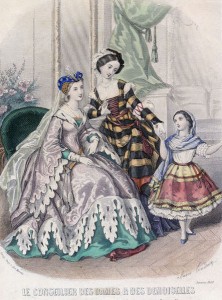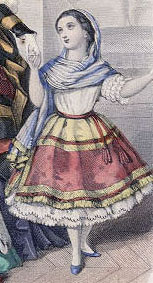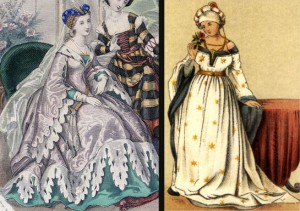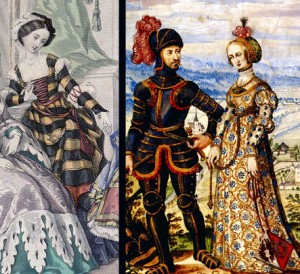Friday’s Fashion Plate
1860 Masquerade Gowns
This is a set of three masquerade or “fancy dress” ensembles from an 1860 French fashion plate. Masquerade fashion plates intrigue me, because they show the Victorian version of historic costuming. Interestingly, no matter what era is represented, you can always see evidence of “modern” styling, such as the hoop skirts beneath a medieval gown.
Right
On the right is a small child in what looks like a folk or peasant costume. She has on a full ruffled skirt that might have a small hoop to hold its shape. Above the skirt she wears a red and yellow striped apron, with a tasseled sash around her waist. A blue scarf wraps around her head and shoulders. Her skirt is short, about knee-length, indicating her young age. Her blouse has fetching ruffled sleeves, and she wears little blue shoes that match her scarf.
Left
On the left is a woman in the Victorian interpretation of a medieval houppelande. Her petticoat is jade green and her dress is a lavender jacquard silk. The dress has wide, dagged sleeves, ermine trim, and a gold girdle. Upon her head she wears a royal blue headdress with a mesh hairnet, a feather accent, and a long, sheer veil. This costume is actually fairly accurate historically, provided you subtract the classic 1860s hoop skirt! Compare it with a work of art depicting a houppelande from 1480.
Center
In the middle is a woman in what I believe to be a kirtle from the 16th century. She wears a high-necked smock underneath, which puffs out at the sleeves. The kirtle has historically innacurate yellow and black stripes and is lined with red. The plain petticoat is navy blue. Compare this with an Austrian painting from the early 1600s.
~~*~~
What do you think of these costumes? Can you identify the eras they represent? Please comment and tell us more about them!




